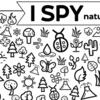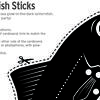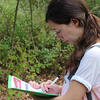Now it’s your turn! What creatures will you find in your own backyard? What creepy observations will you make that you can share with others? Or maybe you’ll make a scary critter of your own! There are so many fun activities you can engage in right at home on in the classroom!
Zoom Into Scary Science: Creepy Creatures
Join the College of Science and Technology to learn about all things creepy, crawly, slimy, hairy! During this family-friendly program, you'll learn more about the invasion of the (icky!) spotted lanternfly and its impact on farming in Pennsylvania from Assistant Professor of Biology Matthew Helmus, who was featured in the New York Times for his lanternfly research. Then it’s on to (scary!) bats — linked with vampires for hundreds of years and a potent symbol for what can go bump in the night — with Brent Sewall, assistant professor of biology, who studies emerging infectious diseases in wildlife, particularly white-nose syndrome in bat populations.
Make Your Own Scary (and Not So Scary) Observations

If you happen to be on campus observing wildlife, studying the plants and trees, or simply wandering in our gardens, why not engage in a little citizen science while you're here? You might come across a creepy critter or two of your own! Record your observations for the Temple Ambler Field Station and the Ambler Arboretum's new project page on iNaturalist! Any iNaturalist observation taken at the Ambler Campus will be automatically uploaded, which will prove invaluable for future campus research! iNaturalist shares your findings with scientific data repositories like the Global Biodiversity Information Facility to help scientists find and use your data. All you have to do is observe. Photo by Scott Ahern.
There's a Bug on Your Head!
That’s probably not something that you want to hear, unless you made the creepy crawler yourself! Join the Ambler Student Life Board in creating your own Creepy Critter Hat! This simple craft requires paper, scissors, glue or tape, and any other fun embellishments you’d like. Use black paper for a spider look, or colored paper to design your very own critter! Make sure to post your final product and tag us @templeambler!
More Creature Crafts and Games at Home
It’s time to get crafty! Can you make your own fish? Will you be the first one to win at Bug Bingo? Try out these crafts at home.
Bug Bingo

Head out into your yard for some Bug Bingo! How many can you find? Try for four across, four down, four diagonally or see if you can cover your whole card! Download a Bingo Card (.pdf).
I Spy

What do you spy with your little eye? In this activity, circle all of the objects you can find in nature. There’s extra credit it you color in the picture! Download Your I Spy page (.pdf).
Make Your Fish Glow!

There are some creatures in nature that can actually create their own light — that’s called bioluminescence! Now you can create one of those critters. Download this amazing lantern fish (and be sure to look them up to learn more about them) and paint it with glow-in-the-dark paint! Download Your Lantern Fish (.pdf).
Keep Looking Up

This one’s a bonus (and not at all scary). As the nights get longer and the days get shorter it’s fun to look up at the night sky and identify the constellations. Now you can take the constellations inside! Cut out all of the circles; use a hole punch where each star is; and then shine a flashlight through the holes to see the constellations on your wall or ceiling at home! Download Your Constellations (.pdf).
Reading is Fundamental!
Do you know where you can find more information about insects, spiders, sharks, scorpions, birds of prey, monsters of the deep, lions, and tigers and bears (oh my!) and more fascinating (and sometimes scary) creatures? At a library of course! The Ambler Campus Library has a bunch of recommendations to continue your journey of discovery and adventure!
We Can All Lend a Hand!

If you're seeking ways that you can engage in science and environmental projects in your community, SciStarter is an excellent repository of thousands of possibilities! SciStarter is an online community dedicated to improving the citizen science experience for project managers and participants. More than 3,000 projects and events are searchable by location, scientific topic, and age level. SciStarter also supports researchers in managing projects, including best practices for engaging participant partners. SciStarter also provides a great overview of citizen science.
Bugs In Our Backyard
Bugs In Our Backyard is an educational outreach and collaborative research program, providing project-based learning opportunities for K-12 students — or anyone! The core activity for Bugs In Our Backyard takes advantage of the bugs in your own backyard, schoolyard or neighborhood. Students become citizen-scientists by surveying this diversity of insects and plants. How much insect diversity can you find? How does insect diversity vary over time? How does insect diversity vary across geographic and urban scales?
Biodiversity PEEK
Biodiversity PEEK (Photography Engaging and Educating Kids) is a citizen science program designed to actively engage local, disadvantaged, public school children with their local overlooked habitats and wildlife through site-adaptable, hands-on, outdoor exploration, digital photography, and the contribution of real scientific data on an online database. The new Biodiversity PEEK preK-8 STEAM curriculum is inquiry-based and project-based learning formed around the Next Generation Science Standards.
SharkBase
Effective management of sharks starts with an understanding of their population status, which will ultimately instruct their future conservation. Through SharkBase, Support Our Sharks is building a global network of shark observers collecting vital information about the abundance and distribution of sharks and rays worldwide (includes all sharks, rays, and chimaeras).
UF Native Buzz
Native Buzz is a citizen science project created by the University of Florida (UF) Honey Bee Research and Extension Lab. Our goal is to learn more about the nesting preferences, diversity and distribution of our native solitary bees and wasps, share the information gained and provide a forum for those interested in participating in the science and art of native beekeeping (and wasp-keeping!).
Urban Buzz — Cicadas
At any given moment we’ve got animals living under our feet — some of them for 17 years at a time. An underground universe populated by mysterious creatures, digging… feeding… emerging. Sometimes their underground homes get paved over, or flooded, or have a bucket of bright green toxic sludge poured on them. Scientists want to learn more about what happens to cicadas when they’re down there for so long — so they need your help. Cicadas are sensitive to changes in their environment, especially temperature and the availability of trees. Researchers are studying how cicadas are responding to environmental changes associated with urbanization (humans building more buildings and paving more land) by measuring the wonkiness (“abnormalities and asymmetry”) in cicada wings and legs.
The Search for Neodietrichia
Welcome to The Search for Neodietrichia! This project started a few years ago when a lab at the University of Indianapolis discovered an undescribed (new to science) Neodietrichia (a type of North American dwarf spider) in central Indiana. This was astonishing to them since the only known Neodietrichia was from California! After years of borrowing specimens from museums, speaking to fellow arachnologists (spider researchers), traveling to various states in search of these spiders, and sampling within Indiana, they have learned that there are likely multiple undescribed Neodietrichia throughout North America just waiting to be discovered!

